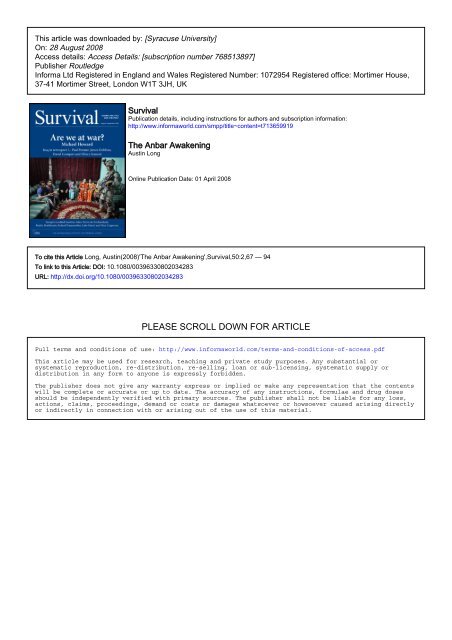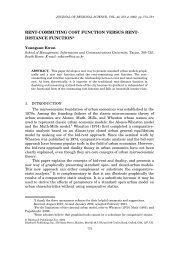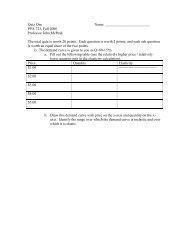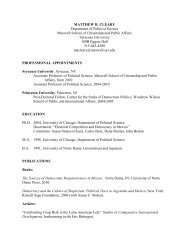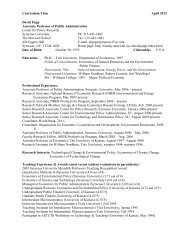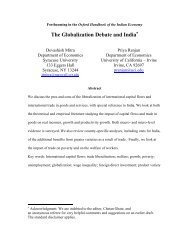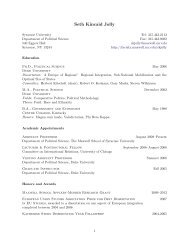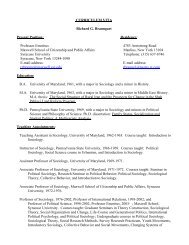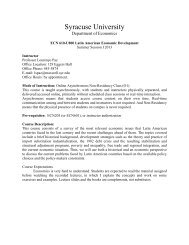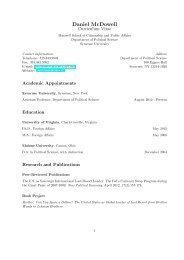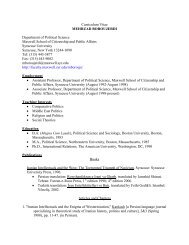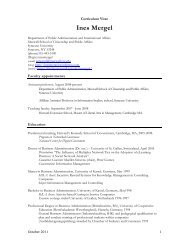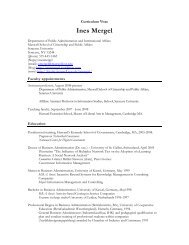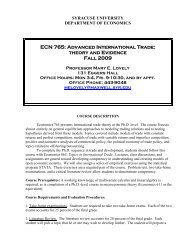The Anbar Awakening - Syracuse University
The Anbar Awakening - Syracuse University
The Anbar Awakening - Syracuse University
Create successful ePaper yourself
Turn your PDF publications into a flip-book with our unique Google optimized e-Paper software.
This article was downloaded by: [<strong>Syracuse</strong> <strong>University</strong>]<br />
On: 28 August 2008<br />
Access details: Access Details: [subscription number 768513897]<br />
Publisher Routledge<br />
Informa Ltd Registered in England and Wales Registered Number: 1072954 Registered office: Mortimer House,<br />
37-41 Mortimer Street, London W1T 3JH, UK<br />
Survival<br />
Publication details, including instructions for authors and subscription information:<br />
http://www.informaworld.com/smpp/title~content=t713659919<br />
<strong>The</strong> <strong>Anbar</strong> <strong>Awakening</strong><br />
Austin Long<br />
Online Publication Date: 01 April 2008<br />
To cite this Article Long, Austin(2008)'<strong>The</strong> <strong>Anbar</strong> <strong>Awakening</strong>',Survival,50:2,67 — 94<br />
To link to this Article: DOI: 10.1080/00396330802034283<br />
URL: http://dx.doi.org/10.1080/00396330802034283<br />
PLEASE SCROLL DOWN FOR ARTICLE<br />
Full terms and conditions of use: http://www.informaworld.com/terms-and-conditions-of-access.pdf<br />
This article may be used for research, teaching and private study purposes. Any substantial or<br />
systematic reproduction, re-distribution, re-selling, loan or sub-licensing, systematic supply or<br />
distribution in any form to anyone is expressly forbidden.<br />
<strong>The</strong> publisher does not give any warranty express or implied or make any representation that the contents<br />
will be complete or accurate or up to date. <strong>The</strong> accuracy of any instructions, formulae and drug doses<br />
should be independently verified with primary sources. <strong>The</strong> publisher shall not be liable for any loss,<br />
actions, claims, proceedings, demand or costs or damages whatsoever or howsoever caused arising directly<br />
or indirectly in connection with or arising out of the use of this material.
Downloaded By: [<strong>Syracuse</strong> <strong>University</strong>] At: 18:08 28 August 2008<br />
<strong>The</strong> <strong>Anbar</strong> <strong>Awakening</strong><br />
Austin Long<br />
In late 2006, after several failed attempts and false starts, a tribal group-<br />
ing in Iraq’s restive province of <strong>Anbar</strong> allied with the United States and the<br />
central government of Iraq to fight ‘al-Qaeda in Mesopotamia’. <strong>The</strong> US alli-<br />
ance with this group, known as the <strong>Anbar</strong> Salvation Council (ASC), was<br />
widely hailed as a breakthrough both by members of the press and some<br />
officials in the US and Iraqi governments. 1 Certainly the ASC’s cooperation<br />
made <strong>Anbar</strong>’s capital Ramadi, previously one of the most violent cities in<br />
Iraq, much safer. Cooperation with the tribes of <strong>Anbar</strong> was not unprece-<br />
dented for Washington and Baghdad, but the alliance with the ASC was<br />
both more public and more dramatic than previous cooperation and saw<br />
significant linking of certain tribes and tribal leaders with the formal gov-<br />
ernment structure of the province. In 2007, the United States military began<br />
seeking to forge similar alliances across Iraq, making <strong>Anbar</strong> the model for<br />
the provision of internal security.<br />
Relying on tribes to provide security is not a new phenomenon for<br />
Iraq. <strong>The</strong> British did so in the 1920s; later Saddam Hussein became a<br />
master of using them to ensure the continuity of his rule, particularly<br />
once the formal Iraqi state and the Ba’ath Party withered in the 1980s and<br />
1990s. While the current attempt in <strong>Anbar</strong> is analogous, it is not identi-<br />
cal, and the differences suggest that it is likely to be less successful in the<br />
long run than Saddam’s effort. Moreover, the current attempt highlights<br />
tension between the means and ends of Iraq strategy. <strong>The</strong> tribal strategy is<br />
Austin Long is an Associate Political Scientist at the RAND Corporation.<br />
Survival | vol. 50 no. 2 | April–May 2008 | pp. 67–94 DOI 10.1080/00396330802034283
Downloaded By: [<strong>Syracuse</strong> <strong>University</strong>] At: 18:08 28 August 2008<br />
68 | Austin Long<br />
a means to achieve one strategic end, fighting al-Qaeda in Mesopotamia,<br />
but is antithetical to another, the creation of a stable, unified and demo-<br />
cratic Iraq.<br />
<strong>The</strong> tribe and the state<br />
<strong>The</strong> nature of tribes can be quite confusing to those unfamiliar with them.<br />
In general, a tribe consists of various smaller clans, in turn composed of<br />
extended families. Members of a tribe claim kinship, which is often based<br />
on association and assertion of a ‘myth of common ancestry’ rather than<br />
actual consanguinity. 2 This asserted relationship is sometimes called ‘fictive<br />
kinship’. Fictive or not, this kinship helps regulate conflict and provides<br />
benefits such as jobs and social welfare in environments where the modern<br />
state does not exist or is too weak to function. 3<br />
In Iraq, both the basic structure of tribes and the terms used to refer to<br />
them have changed over time. In present-day <strong>Anbar</strong>, the basic unit is the<br />
tribe (‘ashira), which is composed of clans (afkhad). <strong>The</strong>se clans are made up<br />
of lineages or households (hamoulas), which are in turn made up of houses<br />
(bayts) that contain individual families (‘ailas). In some cases, the term qabila<br />
is used to refer to a large tribe or confederation of tribes. 4<br />
Saddam Hussein’s tribal position at the time of the second Ba’ath coup<br />
of 1968 provides a good example of this system. His tribe was the Albu<br />
Nasir, one of three main groupings in the town of Tikrit. <strong>The</strong> Albu Nasir had<br />
six clans; Saddam was from the Beijat, the dominant clan. Within the Beijat<br />
clan were ten lineages; Saddam was from the Albu Ghafur lineage. Within<br />
the Albu Ghafur were two main houses; Saddam’s was the Albu Majid. His<br />
family was that of Hussein, though Hussein himself – Saddam’s father –<br />
died before Saddam was born. 5<br />
It is important to note that kinship ties, while important, are not sacro-<br />
sanct, particularly at the more abstract level of tribe and clan. Once again,<br />
Saddam Hussein’s life provides an example. Saddam at the time of the 1968<br />
coup was deputy to his kinsman Ahmad Hassan al-Bakr. Al-Bakr was also<br />
from the Beijat clan. However, as his name indicates, al-Bakr was from a dif-<br />
ferent lineage, the Albu Bakr. Despite these affiliations, Saddam eventually<br />
manoeuvred al-Bakr out of power and made his own lineage, Albu Ghafur,
Downloaded By: [<strong>Syracuse</strong> <strong>University</strong>] At: 18:08 28 August 2008<br />
<strong>The</strong> <strong>Anbar</strong> <strong>Awakening</strong> | 69<br />
supreme. 6 Al-Bakr’s subsequent death under mysterious circumstances is<br />
often attributed to those loyal to Saddam.<br />
Saddam’s closer kinsmen provided a more loyal power base. After the<br />
death of Saddam’s father, his mother’s remarriage to a member of the Albu<br />
Khattab lineage of the Beijat clan gave him three half-<br />
brothers from another lineage. He also drew upon his<br />
close cousins from the Albu Majid house of the Albu<br />
Ghafur lineage to fill his top security ranks. In general,<br />
close kinships like this have far greater strength than the<br />
more abstract links of tribe and clan. 7<br />
<strong>The</strong> impact of tribes on state formation in the Middle<br />
East has varied from state to state. 8 In Iraq in the 1920s, the<br />
tribe was a rural organisation that stood in opposition to<br />
all things urban and modern. Following a revolt against<br />
the new Hashemite monarchy, the British and their allies in the royal family<br />
sought to appease and manipulate the tribes. In exchange for their support,<br />
areas outside cities were in many ways made a law unto themselves. 9<br />
<strong>The</strong> overthrow of the Hashemite monarchy in 1958 initiated a decline in<br />
tribal power, as the new military regime eliminated laws that gave sheikhs<br />
legal authority and control of agricultural land. This led to an exodus from<br />
rural areas to the cities and the first encounters of peasant tribesman with an<br />
alien urban environment. Many used affiliation to anchor themselves in this<br />
often hostile setting and tribalism came to coexist with urban modernity as<br />
ever more Iraqis migrated to towns and cities.<br />
However, though some Iraqis clung to traditional names and affiliations,<br />
tribalism’s power waned through the 1960s. Iraq was slowly but surely<br />
becoming a modern nation-state with a functioning security apparatus,<br />
judiciary and bureaucracy. By the late 1960s, tribalism was at its nadir, with<br />
many Iraqis ceasing to define themselves in the traditional way (though<br />
more than a few existed in a sort of dual state, with membership in both a<br />
tribe and a modern organisation such as a trade union). 10<br />
Saddam’s<br />
closer kinsmen<br />
were a more<br />
loyal power<br />
base<br />
In theory, the return of the Ba’ath Party to power in 1968 (it had briefly<br />
held power in 1963 but was ousted by the military) should have heralded<br />
the death knell of the tribe. Ba’ath ideology is relentlessly secular and mod-
Downloaded By: [<strong>Syracuse</strong> <strong>University</strong>] At: 18:08 28 August 2008<br />
70 | Austin Long<br />
ernist. As Amatzia Baram notes, the first Ba’ath communiqué in July 1968<br />
declared: ‘We are against religious sectarianism, racism, and tribalism’, the<br />
latter being one of ‘the remnants of colonialism’. 11<br />
However, the Ba’ath Party was highly insecure in its control of Iraq. In<br />
order to prevent another coup, the party both massively expanded member-<br />
ship and sought to place loyal elements in the military and security services.<br />
Many of these loyalists were members of the same tribe as the senior leaders<br />
of the party. 12 Thus, from its inception, the Ba’ath regime had an inconsistent<br />
policy and attitude which ensured that tribal power, though temporarily<br />
diminished, would endure.<br />
Tribal–state security relations<br />
<strong>The</strong> Ba’ath government’s use of tribes to control Iraq’s state-security appara-<br />
tus is far from unique. Modern nation-states have in many instances turned<br />
to tribes to help provide internal security, generally because the state is<br />
either too weak to provide security itself or because it is too expensive to do<br />
so. In general, the weaker the state, the more autonomy is given to tribes to<br />
provide what the state cannot.<br />
<strong>The</strong>re are three basic patterns the relationship can take. <strong>The</strong>se are not<br />
necessarily mutually exclusive, so that different patterns can be seen in the<br />
same state. <strong>The</strong> first is most likely in relatively stronger states and occurs<br />
when one group seeks to dominate the state’s security apparatus by com-<br />
mingling tribal networks with the formal state structure. This ‘state tribalism’<br />
is common in states that have not fully institutionalised the mechanism for<br />
providing internal security. 13 In the Middle East, Iraq, Syria and many of the<br />
Gulf States have practiced various forms of state tribalism. 14 Other countries,<br />
such as Jordan, use electoral arrangements favouring tribes to ensure control<br />
of ostensibly democratic legislatures, partly to ensure internal security. 15<br />
Outside the Middle East, this pattern is commonly seen in post-<br />
colonial Africa. Kenya, for example, was dominated in the early post-<br />
colonial period by the Kikuyu tribe. <strong>The</strong> government of Jomo Kenyatta<br />
intentionally filled the army with Kikuyu tribesmen in the late 1960s to<br />
neutralise the Kamba and Kalenjin tribes that had dominated the country<br />
under the British. <strong>The</strong> government also used a paramilitary organisation
Downloaded By: [<strong>Syracuse</strong> <strong>University</strong>] At: 18:08 28 August 2008<br />
<strong>The</strong> <strong>Anbar</strong> <strong>Awakening</strong> | 71<br />
called the General Service Unit as a Kikuyu praetorian guard and ‘Kikuyu-<br />
ised’ the police and other intelligence services. 16 Following the death of<br />
Kenyatta in 1978, Vice President Daniel arap Moi, a member of the Kalenjin<br />
tribe, assumed the presidency and began to seed the security services with<br />
his own kinsmen, allowing him to thwart an attempted coup in 1982. 17 This<br />
pattern of state tribalism in the security services has continued and affilia-<br />
tion remains important to Kenyan politics and the preservation of internal<br />
security. 18<br />
<strong>The</strong> second pattern is common in weaker states and involves quasi-<br />
autonomous militias based on tribe (or more broadly on ethnicity). <strong>The</strong>se<br />
militias are effectively ‘deputised’ to provide internal security in certain<br />
regions in exchange for some form of payment from the central state. This<br />
pattern can be termed ‘auxiliary tribalism’. Afghanistan in the late 1980s<br />
and early 1990s provides one of the best examples of the successful appli-<br />
cation of this pattern as well as a caution about its possible consequences.<br />
<strong>The</strong> Communist government of Afghanistan faced a tenacious multiparty<br />
insurgency beginning in the late 1970s that even major Soviet intervention<br />
was unable to quell. <strong>The</strong> Afghan government began to arm and pay various<br />
tribal and ethnic militias to fight the insurgency, or to at least remain neutral.<br />
This process accelerated after Mohammed Najibullah replaced Babrak<br />
Karmal as president in 1986, and enabled Najibullah’s regime to survive the<br />
Soviet withdrawal in 1989. 19 Perhaps the most famous of these militias was<br />
that of General Abdul Rashid Dostum, an ethnic Uzbek from northwestern<br />
Afghanistan. Dostum’s militia grew from a small force intended to protect<br />
gas fields to over 20,000 men armed with heavy equipment and artillery by<br />
the late 1980s. Dostum was so effective he became a de facto mobile reserve<br />
for the Afghan government. However, when the collapsing Soviet Union<br />
cut funding to Afghanistan and the ability of the Afghan government to pay<br />
declined, Dostum quickly switched sides to the insurgents. This defection<br />
precipitated the rapid collapse of the Afghan government in early 1992. 20<br />
<strong>The</strong> final pattern of relations is the cession of all but the most desul-<br />
tory control over a territory to a tribe. Only the weakest or poorest of states<br />
would normally accept this type of relationship. Tribal leaders become, in<br />
effect, palatine vassals of the central state, and are often as restive as their
Downloaded By: [<strong>Syracuse</strong> <strong>University</strong>] At: 18:08 28 August 2008<br />
72 | Austin Long<br />
medieval counterparts. This pattern can be termed ‘baronial tribalism’. It is<br />
fairly rare, as such feudal relations are anathema to modern nation-states,<br />
but can be seen in Pakistan in the region along the border with Afghanistan.<br />
Either de jure or de facto tribal autonomy characterises much of Baluchistan,<br />
the Federally Administered Tribal Areas (which includes North and South<br />
Waziristan) and the North-West Frontier Province. <strong>The</strong> federal govern-<br />
ment’s presence is felt lightly, if at all (apart from the occasional punitive<br />
expedition), a situation echoing the British imperial experience in these<br />
rugged border regions. 21 Yemen offers another example: clashes between<br />
a very weak central state and well-armed tribes are frequent and violent. 22<br />
However, in most rural regions tribal law is far more powerful than the laws<br />
of the government, so despite these clashes the government also uses tribes<br />
to provide a degree of internal security. 23<br />
A final variation on these three patterns occurs when an external power<br />
becomes involved in the provision of internal security to a state. This<br />
presents the possibility of a three-way relationship among tribe, state and<br />
external power that can produce many complications. <strong>The</strong> external power<br />
might choose to ally itself with groups that are hostile to the state or vice<br />
versa, potentially creating serious problems. Further, the existence of multi-<br />
ple tribes can mean that the external power must also balance relations with<br />
groups that compete among themselves.<br />
<strong>The</strong> United States’ involvement in Vietnam is a good example. In the<br />
early 1960s, the CIA and US Army Special Forces began arming and train-<br />
ing Montagnard tribesmen in the mountainous west of South Vietnam to<br />
fight Communist insurgents supported by North Vietnam (a form of aux-<br />
iliary tribalism). <strong>The</strong> Montagnard recruits were enthusiastic in fighting the<br />
insurgents, yet were only slightly less hostile to the government of South<br />
Vietnam, which had never treated the Montagnard minority particularly<br />
well. <strong>The</strong> government of South Vietnam was understandably nervous<br />
about this programme, known as the Civilian Irregular Defense Group<br />
programme. Tension came to a boil in late 1964, when several groups of<br />
tribesmen rose in open revolt. <strong>The</strong> situation was ultimately defused by<br />
the CIA and Special Forces advisers but could potentially have been much<br />
worse. 24
Downloaded By: [<strong>Syracuse</strong> <strong>University</strong>] At: 18:08 28 August 2008<br />
Saddam’s tribal strategy<br />
<strong>The</strong> <strong>Anbar</strong> <strong>Awakening</strong> | 73<br />
In Iraq, the Ba’ath Party’s relationship to the Iraqi tribes was equivocal from<br />
the beginning. Ideologically and rhetorically opposed to tribalism, the<br />
regime nevertheless practiced a form of state tribalism to remain in power.<br />
Members of Hassan al-Bakr and Saddam Hussein’s Albu Nasir tribe began<br />
to fill the security services in the 1970s, as did members of other favoured<br />
groups like the al-Jubburi. 25<br />
<strong>The</strong> Ba’ath Party in the 1970s had three main mechanisms to conduct<br />
this strategy. <strong>The</strong> first was the Ba’ath military bureau, which selected and<br />
organised party members for military service under the direction of the<br />
Beijat clan. <strong>The</strong> second was the security-service bureau, which was con-<br />
trolled by Saddam. <strong>The</strong> final and most obviously tribal instrument was<br />
the Committee of Tribes (Lajnat al-’Asha’ir), which was established to<br />
work with the tribes of the Sunni Triangle northwest of Baghdad, includ-<br />
ing <strong>Anbar</strong>, to secure the porous Syrian border. 26 <strong>The</strong>se three organisations,<br />
combined with booming oil revenue after the oil shock of 1973, enabled<br />
the Ba’ath Party (and particularly the canny Saddam) to place kinsmen<br />
in power (state tribalism) and buy the loyalty of other clans (auxiliary<br />
tribalism).<br />
<strong>The</strong> overall impact of tribalism on broader Iraqi society, however,<br />
remained muted in the 1970s. This was due to party efforts to weaken tribal<br />
power even as it sought to manipulate it, as well as the continuing mod-<br />
ernisation and urbanisation of Iraq. Land reform was a major part of this,<br />
as the Ba’ath regime redistributed land or gave it to new peasant collec-<br />
tives. Tribesmen, including future sheikhs, often joined the Ba’ath Party and<br />
took up modern professions such as engineering. 27 <strong>The</strong><br />
rural tribes as the British knew them in the 1920s and<br />
1930s had effectively ceased to exist, mostly becoming<br />
rural–urban hybrids.<br />
Events of the late 1970s and early 1980s would force<br />
the Ba’ath Party to increase its reliance on the tribes of<br />
<strong>Anbar</strong> for internal security. <strong>The</strong> Iranian revolution of<br />
<strong>The</strong> rural tribes<br />
had effectively<br />
ceased to exist<br />
1979 seemed to provide Saddam with a golden opportunity to get even<br />
with an Iran that under the Shah had exploited Iraqi weakness. Now in sole
Downloaded By: [<strong>Syracuse</strong> <strong>University</strong>] At: 18:08 28 August 2008<br />
74 | Austin Long<br />
command of Iraq following his ouster of Hassan al-Bakr, Saddam launched<br />
what was intended to be a limited incursion into Iran.<br />
However, Iran’s revolutionary fervour made it an implacable foe, and<br />
soon Saddam was fighting for his survival. In this period, he increasingly<br />
turned to the tribes to provide internal security. This process gathered<br />
momentum after the Iraqi retreat from Khorramshahr in 1982. 28 As the<br />
Iran–Iraq War continued, more and more party members (especially<br />
members of the Ba’ath militia known as the Popular Army) were sent to<br />
the front, thinning out the presence of loyal Ba’athists in tribal areas. This<br />
forced increasing reliance on tribal loyalty and Saddam widened the circle<br />
of tribes he relied on, drawing heavily on the large Dulaimi confederation<br />
of <strong>Anbar</strong>. 29<br />
In addition to this conscious policy, Saddam and the Ba’ath Party also<br />
increased the importance of Iraqi tribes unintentionally by eliminating alter-<br />
native elements of civil society. <strong>The</strong> Ba’athist totalitarian impulse crushed<br />
and absorbed all other forms of ideological organisation such as trade<br />
unions. Even as these alternative institutions contracted, the war consumed<br />
an ever greater portion of Iraq’s wealth and managerial talent. This led to an<br />
accelerating decline of government social-welfare provision. Thus, by the<br />
mid 1980s, many Iraqis found themselves relying more and more on the<br />
social-safety net or personal network provided by the tribe, which therefore<br />
assumed ever greater importance. 30<br />
Following the end of the Iran–Iraq War, Saddam’s invasion of Kuwait led<br />
to further devastation of the Iraqi state and further increases in tribal power.<br />
<strong>The</strong> decimation of the Iraqi military and particularly the regime’s elite<br />
Republican Guard paved the way for widespread revolt in southern Iraq in<br />
1991. <strong>The</strong> Ba’ath Party apparatus, drained by two wars, proved incapable of<br />
suppressing the revolt and Saddam was forced to turn to the tribes, includ-<br />
ing many Shia tribes around Baghdad, to put it down. <strong>The</strong> tribes of <strong>Anbar</strong>,<br />
particularly the Dulaimi, were critical to this effort and became increasingly<br />
integral to regime survival. Some dubbed <strong>Anbar</strong> the ‘White Governate’ to<br />
indicate its importance to the regime. 31<br />
After 1991 the state’s reliance on tribes became truly explicit for the first<br />
time in Ba’athist Iraq, with sheikhs publicly visiting Saddam and being
Downloaded By: [<strong>Syracuse</strong> <strong>University</strong>] At: 18:08 28 August 2008<br />
<strong>The</strong> <strong>Anbar</strong> <strong>Awakening</strong> | 75<br />
praised in the state media. Saddam increasingly went beyond state tribal-<br />
ism and embraced auxiliary tribalism by allowing sheikhs to create their<br />
own private armies equipped with small arms, rocket-propelled grenades,<br />
mortars and allegedly even howitzers. <strong>The</strong>se armies were intended to allow<br />
a sheikh to police his area, and this period also saw increasing legal defer-<br />
ence to tribal customs. 32<br />
By 1996, tribal formations had become so integral to the state that the cre-<br />
ation of a formal High Council of Tribal Chiefs was proposed. Sheikhs were<br />
not only to have judicial and internal security powers but even the ability to<br />
tax on behalf of the central government. In exchange, they would receive not<br />
only money, weapons and equipment, but also land, government rations,<br />
diplomatic passports and exemption from compulsory military duty. Such<br />
was their importance for internal security that in the 1998 confrontation<br />
with the United States tribal units were deployed in large cities to support<br />
the security services. Previously this would have been the duty of the Ba’ath<br />
Party’s Popular Army. 33 That the government even considered ceding this<br />
level of authority to the sheikhs shows that the Iraqi state, weakened by war<br />
and sanctions, was drifting beyond state and auxiliary tribalism and dan-<br />
gerously close to baronial tribalism.<br />
This delegation of power to tribal authorities not only granted them<br />
formal authority but also enhanced their ability to seek extra-legal sources<br />
of additional revenue from smuggling (particularly lucrative as Iraq was<br />
under United Nations sanctions), government corruption and kickbacks,<br />
and even outright extortion and hijacking. Tribal gangs became increas-<br />
ingly common in this period. 34 Members of the Dulaimi, for example, are<br />
alleged to have raided cars and trucks using the Baghdad–Amman highway<br />
through their territory in the late 1990s. Tribal forces also intimidated or even<br />
assassinated state law-enforcement or security personnel; in other instances<br />
they demanded blood money or other compensation from the state for its<br />
actions. This latter practice became so widespread that the Ba’ath regime<br />
issued an edict making it illegal in 1997. 35<br />
<strong>The</strong> 1990s also saw several serious challenges to Saddam’s power by ele-<br />
ments of various tribes, particularly those he had so actively integrated with<br />
the regime. In 1990, members of the Jubburi plotted a coup against Saddam.
Downloaded By: [<strong>Syracuse</strong> <strong>University</strong>] At: 18:08 28 August 2008<br />
76 | Austin Long<br />
<strong>The</strong> Iraqi leader successfully quashed this attempt (though in retaliation<br />
Jubburi pilots are alleged to have attacked the presidential palace) but it<br />
indicated that even his vigorous attempts to buy the loyalty of the tribes had<br />
not produced their unequivocal adherence. 36<br />
<strong>The</strong> most serious challenge began in May 1995, when Saddam returned<br />
the body of executed Brigadier-General Muhammad Mazlum al-Dulaimi to<br />
his family. Mazlum al-Dulaimi, a prominent member of the Dulaimi con-<br />
federation’s Albu Nimr tribe, had been held along with some of his kinsmen<br />
after an alleged coup attempt in 1994. His body and those of his kinsmen<br />
bore marks of horrible torture when finally returned and sections of the<br />
Albu Nimr in the Ramadi area rose in open revolt in response to this prov-<br />
ocation. Other Dulaimi staged an insurrection at the Abu Ghraib military<br />
base in June; some tribesmen who fled to Damascus are alleged to have<br />
proclaimed an ‘Armed al-Dulaim Tribes Sons Movement’. 37<br />
This movement eventually lost momentum and was finally put down by<br />
those loyal to Saddam. This was in large part because not even the major-<br />
ity of the Albu Nimr, much less the majority of the Dulaimi, participated.<br />
Despite this clear and widely reported rebellion, which led to the firing of<br />
Defense Minister Ali Hasan al-Majid, such was the reliance of Saddam on<br />
the tribes that he was unable to simply revoke the privileges of the Dulaimi<br />
or purge them from the security services. 38<br />
Saddam continued to employ a strategy of state and auxiliary tribalism<br />
on the eve of Operation Iraqi Freedom. Tribal forces were to be integrated<br />
with other military and paramilitary formations to prevent an uprising like<br />
that of 1991 and, if needed, to fight invading coalition forces. To ensure<br />
that he could continue to buy tribal loyalty, Saddam removed over a billion<br />
dollars from the Iraqi Central Bank right before the war. 39 Unfortunately<br />
for him, once the attack began the loyalty of the tribes proved ephemeral<br />
and many chose not to fight. A senior military adviser to the Ba’ath Party<br />
near the city of Samawa recalled after the war: ‘<strong>The</strong>y called the tribal chiefs<br />
in As-Samawa to try and get more men, but the tribes said, “We have no<br />
weapons, so how can we fight?” I sensed we were losing control of the<br />
situation – and the American forces had not yet arrived, there were only<br />
air attacks.’ 40
Downloaded By: [<strong>Syracuse</strong> <strong>University</strong>] At: 18:08 28 August 2008<br />
<strong>The</strong> US–Iraqi tribal strategy<br />
<strong>The</strong> <strong>Anbar</strong> <strong>Awakening</strong> | 77<br />
Following the rapid success of US conventional forces in Operation Iraqi<br />
Freedom there was a need to provide internal security across the heteroge-<br />
neous Iraqi nation, including in <strong>Anbar</strong>, the former bastion of the Ba’athist<br />
tribal strategy. Even in concert with Iraq’s interim government, this proved<br />
challenging and 2003–04 saw the birth of an insurgency in <strong>Anbar</strong> and major<br />
anti-coalition violence. Participants in the insurgency<br />
came from a mixture of groups and included former<br />
senior Ba’athists, tribesmen and foreign fighters. Though<br />
their motives differed, these groups made common cause<br />
against the coalition. 41<br />
In this period, the US–Iraqi tribal strategy was rudi-<br />
mentary in <strong>Anbar</strong>. However, by early 2004, US and Iraqi<br />
officials began engaging in dialogue with tribes, and in<br />
limited cases cooperated with them. Still, the tribes overall saw little reason<br />
to support the new order and often sided with the newly declared al-Qaeda<br />
in Mesopotamia or other insurgent groups.<br />
Attitudes began to shift in early 2005, following the massive coalition<br />
assault on Fallujah in November 2004 and the Iraqi national elections in<br />
January 2005. Many tribal leaders began to conclude that the political process<br />
might hold more benefit than continued fighting. Further, al-Qaeda in<br />
Mesopotamia’s transnational and fundamentalist goals were at odds with the<br />
local or national goals of the tribes. Finally, and perhaps most importantly, al-<br />
Qaeda in Mesopotamia was competing for control of revenue sources – such<br />
as banditry and smuggling – that had long been the province of the tribes. 42<br />
Under this interpretation, the tribes did not change sides in response to<br />
violence towards civilians or their <strong>Anbar</strong> kinsmen, as press accounts have<br />
suggested. While this violence was not irrelevant, it does not appear to have<br />
been the central motive for the shift. For example, some began fighting al-<br />
Qaeda in Mesopotamia at least as early as the beginning of 2005, well before<br />
most of the violence towards civilians and tribesmen in <strong>Anbar</strong> occurred.<br />
<strong>The</strong> primary motive was not moral; it was self-interested.<br />
US and Iraqi<br />
officials began<br />
dialogue with<br />
tribes<br />
In fact, it can be argued that much (though far from all) of al-Qaeda’s<br />
violence against Sunnis in <strong>Anbar</strong> was intended to coerce the tribes back into
Downloaded By: [<strong>Syracuse</strong> <strong>University</strong>] At: 18:08 28 August 2008<br />
78 | Austin Long<br />
alignment with the insurgents. Certainly this was the intent of attacks on<br />
selected tribal leaders. In other words, al-Qaeda’s violence was principally<br />
an effect of shifts in allegiance rather than a cause. Though it often appears<br />
senseless and brutal to outsiders, the coercive use of extreme violence in<br />
insurgency and civil war is both fairly common and sometimes quite<br />
effective. 43<br />
This shift in the strategic calculus of the tribes made a successful US–<br />
Iraqi tribal strategy possible, but the opportunity was not fully exploited.<br />
For example, the United States did not take full advantage of a shift among<br />
members of the powerful Dulaimi confederation in western <strong>Anbar</strong>. <strong>The</strong><br />
Albu Mahal tribe around the city of Qaim resented the influx of al-Qaeda in<br />
Mesopotamia to their border town and the group’s competition with Albu<br />
Mahal’s lucrative smuggling operations. With the support of members of<br />
the Albu Nimr, the Albu Mahal formed the Hamza Forces (also called the<br />
Hamza Battalion) to fight the newcomers. Al-Qaeda proved to be a tough<br />
opponent and in May of 2005 the tribes decided to turn to coalition forces<br />
for help in battling them. Fasal al-Gaoud, a former governor of <strong>Anbar</strong> and<br />
sheikh of the Albu Nimr, contacted US Marines for support. 44<br />
<strong>The</strong> marines had already been planning an offensive around Qaim, so<br />
this could have been an ideal moment to cement an alliance. Instead, the<br />
marine offensive, known as Operation Matador, was uncoordinated with the<br />
tribes (some marines appear to have not been informed about the requested<br />
alliance) and made use of intensive firepower, which alienated many tribes-<br />
men by destroying portions of Qaim. Furthermore, the Iraqi government<br />
was hostile to the Hamza Forces, declaring that such vigilantes had no place<br />
in Iraq. 45<br />
After Operation Matador there were no further attempts by the Hamza<br />
Forces to coordinate with the coalition for several months. Without coalition<br />
support, the Hamza Forces were overwhelmed by al-Qaeda in Mesopotamia<br />
by September of 2005. 46 Fortunately, coalition forces in <strong>Anbar</strong> learned from<br />
their earlier mistake and may have begun supporting the Albu Mahal with<br />
air-strikes in late August 2005. 47 This was insufficient, however, to defeat<br />
the powerful al-Qaeda forces around Qaim and in November 2005 coalition<br />
forces launched Operation Steel Curtain. This operation was marked by far
Downloaded By: [<strong>Syracuse</strong> <strong>University</strong>] At: 18:08 28 August 2008<br />
<strong>The</strong> <strong>Anbar</strong> <strong>Awakening</strong> | 79<br />
better coordination with the Albu Mahal, and cooperation improved still<br />
further after the operation, when marines and Iraqi Army personnel stayed<br />
behind to support the Albu Mahal in providing security. 48<br />
<strong>The</strong> eventual success of US–Iraqi coordination with the Albu Mahal in<br />
2005 was not widely emulated, though some tribes did continue to fight<br />
al-Qaeda. For example, members of the Dulaimi confederation fought the<br />
group around Ramadi in August 2005. 49 However, many in the coalition<br />
remained reluctant to fully embrace a tribal strategy. More importantly,<br />
tribal leaders were targeted by al-Qaeda in a coercive campaign of murder<br />
and intimidation which sapped many tribes of the will to fight. 50 <strong>The</strong> success<br />
of the terrorists in this campaign was due in part to the nature of tribal<br />
loyalty. Al-Qaeda was able to turn clans and families from the same tribe<br />
against one another with a combination of carrots (money and other patron-<br />
age) and sticks (threats of assassination).<br />
This pattern of failed efforts to oppose al-Qaeda in <strong>Anbar</strong> continued<br />
into 2006. Elements of the Albu Fahd tribe, for example, began distancing<br />
themselves from al-Qaeda in Ramadi in late 2005 and early 2006. Al-Qaeda<br />
quickly targeted Sheikh Nasr al-Fahdawi and other prominent tribesmen<br />
for assassination, which was carried out in early 2006 (with the support of<br />
some of al-Fahdawi’s pro-al-Qaeda fellow tribesmen). 51 A captured al-Qaeda<br />
document from this period reveals this strategy. Noting that tribal leaders<br />
had begun to cooperate with Americans, the authors write: ‘we found that<br />
the best solutions [sic] to stop thousands of people from renouncing their<br />
religion, is to cut the heads of the Sheiks of infidelity’. 52 <strong>The</strong>y accuse Sheikh<br />
Nasr al-Fahdawi of using his money, power and reputation in Ramadi to<br />
‘violate’ the authors’ ‘brothers’, continuing: ‘so the brothers raided his house<br />
in the middle of the night wearing the national guards uniform and driving<br />
similar cars, they took him and killed him thank god’. 53<br />
Al-Qaeda in Mesopotamia’s campaign of murder and intimidation had<br />
the desired effect, as the document notes:<br />
<strong>The</strong>n there was a complete change of events than is was [sic] before thank<br />
god, cousins of Sheik Nasr came to the Mujahidin begging, announcing<br />
their repentance and innocence, saying we’re with you, we’ll do whatever
Downloaded By: [<strong>Syracuse</strong> <strong>University</strong>] At: 18:08 28 August 2008<br />
80 | Austin Long<br />
you want. <strong>The</strong> turmoil is over, our brothers now are roaming the streets of<br />
AlbuFahd without any checkpoints. 54<br />
<strong>The</strong> document goes on to list others who were killed or intimidated, indicat-<br />
ing that the terrorists’ coercive violence was successful. 55<br />
Coalition cooperation with the tribes remained limited through early<br />
2006. 56 <strong>The</strong>re were some exceptional success stories, as with the Albu Mahal<br />
and US Army Special Forces relationship with the Albu Nimr around the<br />
city of Hit. Even in these limited cases, al-Qaeda recognised the threat and<br />
sought to target these tribes. In captured documents, the group noted the<br />
need to attack the Albu Nimr and regretted not crushing the Albu Mahal<br />
when it had the chance. 57<br />
Starting in mid to late 2006, however, the cooperation started to become<br />
more serious. In Ramadi, Sheikh Sattar al-Rishawi of the Dulaimi confed-<br />
eration’s Albu Risha tribe formally launched a concerted campaign against<br />
al-Qaeda in September 2006. Along with other leaders such as the Albu<br />
Nimr’s Fasal al-Gaoud, Sattar founded a tribal alliance known as the <strong>Anbar</strong><br />
Salvation Council (ASC).<br />
Sattar himself was a smuggler and highway robber, and a fairly minor<br />
sheikh. However, he was bold and charismatic and had shrewd advisers<br />
such as his brother Ahmed; when opportunities presented themselves he<br />
was well positioned to take advantage. Sattar had previously been willing to<br />
work with al-Qaeda in Mesopotamia, but began to clash with the group as<br />
it muscled in on his illegal revenue. In 2005, Sattar turned to other Iraqis to<br />
help him battle his unwelcome competitors, but this alliance was ineffective<br />
and short lived. He subsequently seems to have realised that the best way to<br />
defeat al-Qaeda and gain power was to side with the United States. 58<br />
Sattar and his new alliance were soon supported by the coalition. <strong>The</strong><br />
US military helped to protect Sattar, and the government of Iraq embraced<br />
him, albeit reluctantly, as well. Sattar was eventually made the counter-<br />
insurgency coordinator for the province, his tribesmen joined the Iraqi<br />
Police around Ramadi in droves, and his militias were formally deputised<br />
as ‘Emergency Response Units’. A blind eye was turned to Sattar’s extra-<br />
legal revenue generation. 59
Downloaded By: [<strong>Syracuse</strong> <strong>University</strong>] At: 18:08 28 August 2008<br />
<strong>The</strong> <strong>Anbar</strong> <strong>Awakening</strong> | 81<br />
With the Albu Mahal and the Albu Risha, the coalition was clearly employ-<br />
ing both state-tribalism and auxiliary-tribalism strategies to provide internal<br />
security. <strong>The</strong> Albu Mahal were allowed to effectively take<br />
over the Iraqi Army brigade in their region, while the Albu<br />
Risha came to dominate the Ramadi Police. 60 <strong>The</strong> Iraqi<br />
government delegated significant authority to both tribes,<br />
along with the Albu Nimr around Hit.<br />
<strong>The</strong> effect of this strategy in 2007 was dramatic. By the<br />
late spring and early summer, parts of <strong>Anbar</strong> (such as<br />
Ramadi) that had previously been horrifically violent were relatively peace-<br />
ful. Sattar was hailed as a hero by many Iraqis and Americans.<br />
<strong>The</strong> success was striking enough that the coalition attempted to dupli-<br />
cate the model across Iraq, giving rise to the euphemism ‘concerned<br />
local citizens’ or ‘CLCs’ (presumably to make the use of tribesmen and<br />
other former insurgents sound more palatable). <strong>The</strong>se fighters have been<br />
recruited to help the coalition in Baghdad and in parts of Salah ad Din and<br />
Diyala provinces. 61 <strong>The</strong>re are also efforts to expand the strategy to the Shia<br />
south of Iraq. 62 By mid 2007, Saddam’s tribal strategy had in effect become<br />
the coalition’s.<br />
Comparing strategies<br />
Despite the similarities between Saddam’s relatively successfully strategy<br />
and the coalition’s present-day efforts, there is no guarantee that the coali-<br />
tion will prevail. <strong>The</strong> two have very different contexts.<br />
<strong>The</strong> first and most obvious difference is the role of the United States as<br />
a third party. This creates the possibility for tension between Baghdad and<br />
Washington regarding the means and ends of any tribal strategy. Presently,<br />
the government of Prime Minister Nuri al-Maliki is supporting the strategy,<br />
albeit with reservations. His government has been unable to establish secu-<br />
rity and has little authority in <strong>Anbar</strong>, so some formal deputisation of tribes<br />
there does not represent a tangible loss of government power. However,<br />
some Shi’ites may cease to support what they regard as a generous approach<br />
to the Sunni; the political coalition that supports al-Maliki is already fraying<br />
and might not survive.<br />
<strong>The</strong> effect of<br />
this strategy<br />
was dramatic
Downloaded By: [<strong>Syracuse</strong> <strong>University</strong>] At: 18:08 28 August 2008<br />
82 | Austin Long<br />
This would confront the United States with a dilemma similar to that<br />
it faced in Vietnam’s highlands in the 1960s. Supporting the tribes would<br />
increase the likelihood of success against the insurgents, but would alien-<br />
ate the government and possibly precipitate government–tribe conflict<br />
or even the collapse of the frail Iraqi state. Supporting the government<br />
would make the survival of a unified Iraq more likely, but could drive the<br />
tribes back to the insurgency. This situation would actually be worse than<br />
Vietnam; the Sunni tribes of <strong>Anbar</strong> are not a small rural minority like the<br />
Montagnard, which makes it harder for the coalition to exert leverage over<br />
them.<br />
<strong>The</strong>se tensions highlight a second and related difference between Saddam’s<br />
and the coalition’s tribal strategies. Saddam’s strategy was relatively simple<br />
in that it had only one goal: keeping Saddam in power. <strong>The</strong> United States<br />
has at least two goals: achieving a stable, democratic Iraq and defeating al-<br />
Qaeda in Mesopotamia. If the Iraqi government ceases to support the tribal<br />
strategy, these two goals would become mutually exclusive, at least in the<br />
short run. Already, the strengthening of unelected sheikhs in <strong>Anbar</strong> means<br />
an end to democracy in that province, at least for the present.<br />
Further, the tribes themselves are no more unified now than they were<br />
under Saddam. <strong>The</strong> potential for both inter- and intra-tribal conflict remains.<br />
Some reports suggest that friction within the ASC is already high. Even if<br />
this is overstated it illustrates the potential for conflict in the future. Other<br />
tribes are reported to feel neglected or excluded from government and secu-<br />
rity-force positions. 63<br />
Intra-tribal relations can be equally challenging. As an example, in the<br />
powerful Albu Nimr, Sheikh Fasal al-Gaoud was relatively weak despite<br />
(or perhaps because of) being the former governor of <strong>Anbar</strong>. <strong>The</strong> real power<br />
in the Albu Nimr belongs to other members of his lineage, such as Sheikhs<br />
Jubair and Hatem al-Gaoud. Hatem and Jubair in turn have some rivalry<br />
despite being not only from the same lineage but the same house (Hatem is<br />
Jubair’s nephew). 64<br />
While Hatem and Jubair have a good relationship with US special-<br />
operations forces, other members of the al-Gaoud family had close links to<br />
Saddam Hussein. Sattam al-Gaoud was the director of the largest network
Downloaded By: [<strong>Syracuse</strong> <strong>University</strong>] At: 18:08 28 August 2008<br />
<strong>The</strong> <strong>Anbar</strong> <strong>Awakening</strong> | 83<br />
of Iraqi front companies involved in smuggling for the regime. <strong>The</strong> network,<br />
Al-Eman, had numerous al-Gaoud family members in key positions. Sattam<br />
and many of his relatives were also associated with the Iraqi Intelligence<br />
Service. 65 While they have taken to spending much of their time in Jordan<br />
since the fall of Saddam, these al-Gaouds retain both wealth and connec-<br />
tions inside Iraq, including to insurgent groups. 66<br />
This tangled family situation represents the intricacies of just one promi-<br />
nent family in one prominent tribe. As it expands its tribal strategy in Iraq,<br />
the United States will have to manage dozens or even hundreds of these<br />
relationships, leading one intelligence officer in <strong>Anbar</strong> to compare Iraqi<br />
tribal relations to Latin American telenovelas in drama and complexity. 67<br />
Because Washington lacks the detailed knowledge of Iraqi<br />
clans possessed by Saddam, its approach is more like the<br />
British approach of the 1920s. Rather than managing the<br />
tribes, it is simply ceding <strong>Anbar</strong> to them, and potentially<br />
other territories as well. This cession undermines the past<br />
five decades of attempts to build a modern state in Iraq.<br />
<strong>The</strong> third difference between the two strategies is the<br />
relative strength of the Iraqi state. Under Saddam, the<br />
Washington<br />
is simply<br />
ceding <strong>Anbar</strong><br />
to the tribes<br />
state was battered by two decades of war and sanctions, yet it nonetheless<br />
retained significant coercive capability. This was due in no small part to<br />
Saddam’s ruthless willingness to cause civilian casualties and suffering, and<br />
the state’s large numbers of military and security-service personnel backed<br />
by totalitarian intelligence services. On the eve of Operation Iraqi Freedom, for<br />
example, Saddam is estimated to have had about 400,000 military personnel<br />
supplemented by perhaps as many police and security-service members.<br />
In contrast, the current Iraqi government has an authorised military end<br />
strength of 175,000, supplemented by a Ministry of Interior which has over<br />
320,000 personnel on its payroll. Taking these numbers at face value, Saddam<br />
had a 50% advantage in total personnel, and more than double the number<br />
of military personnel. Yet the modern Iraqi military and security services<br />
are in reality nowhere near their authorised strength; indeed the Ministry of<br />
Interior is unable to determine which if any of its 320,000 employees is actu-<br />
ally working. Further, the Iraqi military lacks much of the heavy equipment
Downloaded By: [<strong>Syracuse</strong> <strong>University</strong>] At: 18:08 28 August 2008<br />
84 | Austin Long<br />
that enabled Saddam to punish tribal uprisings such as the Albu Nimr’s<br />
1995 revolt. 68<br />
Admittedly, the government of Iraq does possess one significant tool of<br />
coercion: the United States military. Yet the United States lacks the ruthless-<br />
ness of Saddam, and its forces are better suited to conventional battle than<br />
internal security. Also, the United States will clearly not maintain major<br />
force levels in Iraq indefinitely, so this coercive tool is a temporary asset for<br />
the government of Iraq. Whereas Saddam was able to restrict the power of<br />
the tribes to some degree, the present government of Iraq could soon face a<br />
situation in which baronial tribalism reigns throughout <strong>Anbar</strong>.<br />
<strong>The</strong> fourth difference is the nature of the enemy that the respective tribal<br />
strategies are intended to defeat. Saddam’s strategy was primarily aimed at<br />
other Sunni tribes and the restive Shia. Neither of these enemies had either<br />
motive or opportunity to outbid Saddam for the loyalty of tribes; the combi-<br />
nation of carrots and sticks he could wield was too compelling.<br />
Al-Qaeda in Mesopotamia, on the other hand, possesses a real capac-<br />
ity to outbid the coalition as it attempts to build alliances. Moreover, it is<br />
still capable of murder and intimidation against tribal leaders. For example,<br />
al-Qaeda is believed to be behind the bombing of the Mansour Hotel in<br />
June 2007 that killed Fasal al-Gaoud, the Albu Nimr sheikh who had long<br />
sought to arrange coalition cooperation with the tribes. <strong>The</strong> bombing also<br />
killed two other leaders of the Albu Nimr and a sheikh of the Albu Fahd,<br />
who had once again switched sides to join the ASC. 69 Other killings of ASC<br />
members take place frequently despite US support and protection. 70 Sunnis<br />
who have joined with the coalition in Baghdad and elsewhere also face<br />
fierce reprisals. 71<br />
Most notably, Sheikh Sattar was killed on 13 September 2007 by an impro-<br />
vised explosive device emplaced near his farm outside Ramadi. Unlike many<br />
previous assassinations of tribal leaders, this attack did not demolish the<br />
will to fight of the Albu Risha or the ASC. 72 Sattar’s brother Ahmed quickly<br />
stepped into his place, and while lacking some of Sattar’s charisma, he is<br />
a capable leader. He has begun negotiations with Shia leaders and, realis-<br />
ing that his tribal power base is limited, has attempted to build a political<br />
base beyond his tribe. 73 However, the fact that Sattar was killed in essentially
Downloaded By: [<strong>Syracuse</strong> <strong>University</strong>] At: 18:08 28 August 2008<br />
<strong>The</strong> <strong>Anbar</strong> <strong>Awakening</strong> | 85<br />
his own backyard despite significant ASC and coalition protection suggests<br />
that al-Qaeda (who may have bribed one or more of Sattar’s guards) retains<br />
the ability to use coercive violence against even well-guarded senior figures,<br />
let alone rank-and-file tribesmen. 74<br />
Al-Qaeda in Mesopotamia still has substantial revenue from activities<br />
in Iraq as well as donations from abroad (according to some reports it has<br />
sufficient excess revenue to fund al-Qaeda in Pakistan in addition to its own<br />
efforts). 75 Al-Qaeda thus has significant carrots and sticks with which to<br />
motivate the tribes, or portions thereof, to switch sides.<br />
Moreover, whereas Saddam, like the members of al-Qaeda in Meso-<br />
potamia, was a Sunni, the current government of Iraq is principally Shia.<br />
Many Sunni believe it is little more than a tool of Iran. Shia death squads<br />
have carried out ethnic cleansing in Baghdad and have infiltrated parts<br />
of the Iraqi government. In November 2007 senior leaders in <strong>Anbar</strong> com-<br />
plained that the government was not providing them sufficient resources,<br />
which they attributed to the government’s sectarian bias. Leaders south<br />
of Baghdad have made similar complaints. 76 This perception of bias could<br />
make the tribes more inclined to listen to al-Qaeda, which can portray itself<br />
as seeking to protect the Sunni and limit the influence of Iran. This will be<br />
particularly true if sectarian violence rises again.<br />
Looking to the future<br />
With these key differences in mind, two scenarios can be envisioned for<br />
the next two to three years. In the first, current trends continue unchanged.<br />
<strong>The</strong> government of Iraq continues to embrace the current tribal strategy,<br />
and there remains sufficient US combat power to support and protect the<br />
tribes in <strong>Anbar</strong> and elsewhere. Patronage from both the government of Iraq<br />
and the United States continues to flow and the tribes’ extra-legal income<br />
remains lucrative, while sectarian violence does not worsen.<br />
This scenario looks favourable for the United States, as it would mean<br />
that al-Qaeda in Mesopotamia would be substantially weakened (though<br />
probably not eliminated). <strong>The</strong> trade-off for allowing continued state and<br />
auxiliary tribalism would be the possibility of putting democratisation on<br />
hold: elections in <strong>Anbar</strong> would likely be postponed or the formal structure
Downloaded By: [<strong>Syracuse</strong> <strong>University</strong>] At: 18:08 28 August 2008<br />
86 | Austin Long<br />
of governance marginalised. Though unfortunate, this would not neces-<br />
sarily be permanent and would probably be accepted in the short term by<br />
many residents of <strong>Anbar</strong> as the price of security. It is possible that the ASC<br />
could jointly assume governing authority with provincial officials as part of<br />
a state-of-emergency government. And if Sheikh Ahmed succeeds in creat-<br />
ing a non-tribal party, local democracy might even be preserved.<br />
For the government of Iraq, this scenario means accepting a short- to<br />
medium-term continuation of Saddam’s tribal strategy with all the hazards<br />
that entails. <strong>The</strong> loyalty of the tribes would have to be continually paid for<br />
and relationships both with and among the tribes would have to be managed.<br />
<strong>Anbar</strong> would enjoy at least as much autonomy as it enjoyed under Saddam,<br />
when it was governed by a system approaching baronial tribalism. Indeed,<br />
the government of Iraq would have little more control over <strong>Anbar</strong> than the<br />
government of Pakistan does over its western provinces. Further, by allow-<br />
ing the tribes a virtual monopoly on military and security forces in <strong>Anbar</strong>,<br />
the strategy would make future coups or civil war possible. <strong>The</strong> power of<br />
A much worse<br />
outcome is<br />
easily imagined<br />
tribes in other regions would be expanded as well. For<br />
the Shia majority of Iraq, this might be acceptable but<br />
would remain worrisome.<br />
As problematic as the above outcome would be,<br />
a much worse outcome is easily imagined simply by<br />
factoring in likely medium-term events, among them<br />
a withdrawal of US forces that is not precipitous but<br />
nonetheless substantially reduces combat power in <strong>Anbar</strong> and other prov-<br />
inces. This would mean less ability to protect and support the ASC and other<br />
tribes. It would also make the supply of material support and patronage by<br />
the United States more difficult (though not impossible).<br />
At the same time, the al-Maliki government as currently constituted is<br />
likely to change. It could shift towards a more hardline Shia position or be sup-<br />
planted entirely. Regardless, its support for the tribes will probably decrease<br />
if not end altogether. <strong>The</strong> combination of a US drawdown and a shift in the<br />
position of the Iraqi government could exacerbate sectarian violence.<br />
Even as coalition support to the tribes wanes, al-Qaeda in Mesopotamia<br />
is likely to retain much of its ability to employ both carrots and sticks. <strong>The</strong>
Downloaded By: [<strong>Syracuse</strong> <strong>University</strong>] At: 18:08 28 August 2008<br />
<strong>The</strong> <strong>Anbar</strong> <strong>Awakening</strong> | 87<br />
tribes may therefore be made ‘an offer they can’t refuse’. Like Rashid Dostum<br />
in Afghanistan, they could readily conclude that switching sides was in their<br />
best interest. This would be a particularly bad outcome for the coalition as<br />
it would have helped train, equip and sustain forces that would then begin<br />
to work against it. For the United States, this would mean <strong>Anbar</strong> and other<br />
regions would become havens for al-Qaeda as it worked to destabilise the<br />
region and possibly support attacks further afield. For the government of<br />
Iraq, it would mean de facto partition, civil war, or both.<br />
Finally, it is not clear that the present internal-security model can be<br />
expanded to the Shia south. <strong>The</strong> power of the tribes dwindled more in the face<br />
of modernisation among the Shia than it did among the Sunni. <strong>The</strong> tribe was<br />
replaced or at least modified by the power of political Islam, so that in Shia<br />
areas political-religious parties or groups tend to dominate. 77 <strong>The</strong> largest at<br />
present are Moqtada al-Sadr’s Office of the Martyr Sadr and affiliated militia<br />
Jaiysh al-Mahdi; and Abdul Aziz al-Hakim’s Supreme Iraqi Islamic Council<br />
and affiliated militia, the Badr Organisation. However, there are numerous<br />
other groups with affiliated militias including the Fadhila Party and several<br />
smaller organisations. While tribal groups are not wholly absent, they lack<br />
the power and organisation of these religious-political groups. In Basra, for<br />
example, armed tribesmen play a role in the fighting but the major factions are<br />
party militias. 78 So even if the United States’ tribal strategy succeeds in the Sunni<br />
centre and west of Iraq, the Shia south would likely remain problematic.<br />
* * *<br />
Fully embracing a tribal strategy for internal security in <strong>Anbar</strong> has been<br />
successful to date and expansion of this strategy over the rest of Iraq could<br />
provide real short-term security gains in at least some areas. <strong>The</strong>re is little<br />
guarantee that these gains will persist, however, and there is some chance<br />
that the strategy will backfire in the medium term. Even Saddam Hussein<br />
had difficulty managing Iraq’s tribes despite his totalitarian state and lavish<br />
patronage. As the United States prepares to reduce its commitment to Iraq,<br />
it should be clear on both the tension in its strategic goals and the potential<br />
for the tribes to once again switch sides.
Downloaded By: [<strong>Syracuse</strong> <strong>University</strong>] At: 18:08 28 August 2008<br />
88 | Austin Long<br />
Beyond Iraq, there has been discussion of a US alliance with tribes<br />
in Pakistan to fight al-Qaeda and the Taliban in the border region with<br />
Afghanistan. This alliance would face a welter of problems, including the<br />
lack of US combat forces in Pakistan and the fact that the Taliban and al-<br />
Qaeda in Pakistan have had years to integrate with and even dominate the<br />
area’s tribes. 79 Beyond these daunting issues, the central challenge would<br />
remain the same as in Iraq: managing a three-cornered relationship between<br />
the tribes, the state and an external power as well as inter- and intra-tribal<br />
relations.<br />
<strong>The</strong> tribe and the modern bureaucratic state are inherently in tension.<br />
Max Weber identified this difficulty nearly a century ago: tribes derive legit-<br />
imacy from what he termed ‘the authority of the eternal yesterday’ while the<br />
modern state derives legitimacy from the rational application of the rule of<br />
law. 80 Attempting to use the former to secure the latter is at best a stop-gap<br />
measure. At worst, it sows the seeds of future state failure.<br />
Notes<br />
1 ‘Al-Qaeda in Mesopotamia’ and ‘<strong>Anbar</strong><br />
Salvation Council’ (ASC) are the terms<br />
used throughout this paper, though<br />
both groups are known by other<br />
names. Al-Qaeda in Mesopotamia is<br />
more officially ‘<strong>The</strong> Organisation of al-<br />
Qaeda (the Base) in the Land of Two<br />
Rivers’ and has overlapping and often<br />
interchangeable membership with the<br />
Mujahedin Shura Council, the Islamic<br />
State of Iraq, and Jamaat al-Tahwid<br />
Wa al-Jihad (Group for Monotheism<br />
and Holy War). <strong>The</strong> <strong>Anbar</strong> Salvation<br />
Council is also referred to as the<br />
’Sahawa al-<strong>Anbar</strong>’ (<strong>Anbar</strong> <strong>Awakening</strong>)<br />
or more recently ’Sahawa al-Iraq’ (Iraq<br />
<strong>Awakening</strong>), often abbreviated SAA<br />
and SAI.<br />
2 See Albert Hourani, ‘Conclusion:<br />
Tribes and States in Islamic History’,<br />
in Philip Khoury and Joseph Kostiner<br />
(eds), Tribes and State Formation in the<br />
Middle East (Berkley, CA: <strong>University</strong> of<br />
California Press, 1990), pp. 304–6.<br />
3 Abbas Kelidar provides a concise<br />
summary of the historical weakness<br />
of the Iraqi state in ‘States without<br />
Foundation: <strong>The</strong> Political Evolution<br />
of State and Society in the Arab East’,<br />
Journal of Contemporary History, vol. 28,<br />
no. 2, April 1993, pp. 315–39.<br />
4 See Hosham Dawood, ‘<strong>The</strong> ‘Stateization<br />
of the Tribe and the Tribalization<br />
of the State: the Case of Iraq’, in Faleh<br />
Jabar and Hosham Dawood (eds), Tribes<br />
and Power: Nationalism and Ethnicity in<br />
the Middle East (London: Saqi Books,<br />
2003), pp. 115–16.<br />
5 This summary is drawn from Faleh<br />
Jabar, ‘Sheikhs and Ideologues:<br />
Deconstruction and Reconstruction<br />
of Tribes Under Patrimonial
Downloaded By: [<strong>Syracuse</strong> <strong>University</strong>] At: 18:08 28 August 2008<br />
Totalitarianism in Iraq, 1968–1998’, in<br />
Jabar and Dawood, pp. 103–5.<br />
6 See Ibid., pp. 85–8.<br />
7 Ibid., p. 87.<br />
8 See Khoury and Kostiner, Tribes and<br />
State Formation in the Middle East.<br />
9 Jabar, ‘Sheikhs and Ideologues’, pp.<br />
75–8; and Amal Vinogradov, ‘<strong>The</strong><br />
1920 Revolt in Iraq Reconsidered: <strong>The</strong><br />
Role of Tribes in National Politics’,<br />
International Journal of Middle East<br />
Studies, vol. 3, no. 2, April 1972,<br />
pp.123–39.<br />
10 See Jabar, ‘Sheikhs and Ideologues’,<br />
pp. 75–9. For a much more detailed<br />
account, see Hanna Batatu, <strong>The</strong> Old<br />
Social Classes and the Revolutionary<br />
Movements of Iraq: A Study of Iraq’s Old<br />
Landed and Commercial Classes and of its<br />
Communists, Ba’athists, and Free Officers<br />
(Princeton, NJ: Princeton <strong>University</strong><br />
Press, 1978).<br />
11 Amatzia Baram, ‘Neo-tribalism in<br />
Iraq: Saddam Hussein’s Tribal Policies,<br />
1991–1996’, International Journal of<br />
Middle East Studies, vol. 29, no. 1,<br />
February 1997, p. 1.<br />
12 Jabar, ‘Sheikhs and Ideologues,’ pp.<br />
80–3.<br />
13 Jabar refers to this as ‘etatist tribalism’.<br />
Ibid., pp. 69 and 79–80.<br />
14 See James Quinlivan, ‘Coup-proofing:<br />
Its Practice and Consequences in the<br />
Middle East’, International Security,<br />
vol. 24, no. 2, Autumn 1999, pp.<br />
131–65.<br />
15 See ‘Islamists’ Electoral Disaster’,<br />
Economist Intelligence Unit, 22<br />
November 2007, http://www.<br />
economist.com/daily/news/<br />
displaystory.cfm?story_id=10178007.<br />
16 Mordechai Tamarkin, ‘<strong>The</strong> Roots of<br />
Political Stability in Kenya’, African<br />
<strong>The</strong> <strong>Anbar</strong> <strong>Awakening</strong> | 89<br />
Affairs, vol. 77, no. 308, July 1978, pp.<br />
300–1.<br />
17 Samuel Decalo, ‘Modalities of Civil–<br />
Military Stability in Africa’, Journal of<br />
Modern African Studies, vol. 27, no. 4,<br />
December 1989, p. 557.<br />
18 See ‘Going Up or Down?’, <strong>The</strong><br />
Economist, 7 June 2007, http://www.<br />
economist.com/world/africa/<br />
displaystory.cfm?story_id=9304146,<br />
for comments on the continued importance<br />
of tribe in Kenyan politics.<br />
19 Mark Fineman, ‘Militias Reflect<br />
Tribal Splits’, Los Angeles Times, 1<br />
October 1989; and Charles Dunbar,<br />
‘Afghanistan in 1986: <strong>The</strong> Balance<br />
Endures’, Asian Survey, vol. 27, no. 2,<br />
February 1987, pp. 128 and 134–5.<br />
20 Mark Fineman, ‘Powerful Militia<br />
Unit in Open Revolt Against Kabul<br />
Regime’, Los Angeles Times, 15 March<br />
1992; Mark Fineman, ‘Afghan Leader<br />
Forced Out by Army, Rebels’, Los<br />
Angeles Times, 17 April 1992; and<br />
Shah Tarzi, ‘Afghanistan in 1992: A<br />
Hobbesian State of Nature’, Asian<br />
Survey, vol. 33, no. 2, February 1993,<br />
pp. 165–6.<br />
21 See Asaf Hussain, ‘Ethnicity, National<br />
Identity and Praetorianism: <strong>The</strong> Case<br />
of Pakistan’, Asian Survey, vol. 16, no.<br />
10, October 1976, pp. 925–30; ‘Turning<br />
a Fight into a War’, <strong>The</strong> Economist, 29<br />
June 2006, http://www.economist.com/<br />
world/asia/displaystory.cfm?story_<br />
id=7121811; and ‘<strong>The</strong> Frontier Spirit’,<br />
<strong>The</strong> Economist, 13 December 2006,<br />
http://www.economist.com/world/<br />
asia/displaystory.cfm?story_id=<br />
8413130.<br />
22 For example, see Mohammed Bin<br />
Sallam, ‘Sa’ada War Due to Break<br />
Out as Mediation Committee
Downloaded By: [<strong>Syracuse</strong> <strong>University</strong>] At: 18:08 28 August 2008<br />
90 | Austin Long<br />
Ceased Work’, Yemen Times, 11<br />
November 2007, http://www.<br />
yementimes.com/article.shtml?i=110<br />
2&p=local&a=1; and ‘Calm Returns<br />
to Shabwa Following Clash between<br />
Government and Bilharith Tribe’,<br />
Yemen Times, 9 November 2007,<br />
http://www.yementimes.com/article.<br />
shtml?i=1102&p=local&a=4.<br />
23 Michael Slackman and Mohammed<br />
Al-Asadi, ‘German Family is<br />
Kidnapped by Yemeni Tribe’, New<br />
York Times, 29 December 2005, http://<br />
www.nytimes.com/2005/12/29/international/middleeast/29yemen.html.<br />
24 On CIDG, see Francis Kelly, US Army<br />
Special Forces 1961–1971 (Washington<br />
DC: Center for Military History, 1973),<br />
chapters 3, 5, and 6; and Thomas<br />
Ahern, CIA and Rural Pacification in<br />
South Vietnam (Washington DC: Center<br />
for the Study of Intelligence, 2001),<br />
chapters 3, 5 and pp. 179–82.<br />
25 Baram, ‘Neo-tribalism’, p. 5.<br />
26 Jabar, ‘Sheikhs and Ideologues’, pp.<br />
81–3.<br />
27 Baram, ‘Neo-tribalism’, pp. 3–4.<br />
28 Baram, ‘Neo-tribalism’, p. 5.<br />
29 Keiko Sakai, ‘Tribalization as a Tool<br />
of State Control in Iraq: Observations<br />
on the Army, the Cabinets, and the<br />
National Assembly’, in Jabar and<br />
Dawood, p. 152; Baram, ‘Neo-tribalism’,<br />
p. 7; and Jabar, ‘Sheikhs and<br />
Ideologues’, p. 90.<br />
30 Jabar, ‘Sheikhs and Ideologues’, pp.<br />
88–9.<br />
31 Baram, ‘Neo-tribalism’, p. 7; Jabar,<br />
‘Sheikhs and Ideologues’, pp. 92–3;<br />
and David Wurmser, ‘Coping with<br />
Crumbling States: A Western and<br />
Israeli Balance of Power Strategy for<br />
the Levant’, Institute for Advanced<br />
Strategic and Political Studies<br />
Research Paper, December 1996, pp.<br />
9–10. For more on the regime’s efforts<br />
to provide internal security, see Kevin<br />
Woods et al., Iraqi Perspectives Project:<br />
A View of Operation Iraqi Freedom from<br />
Saddam’s Senior Leadership (Norfolk,<br />
VA: Joint Center for Operational<br />
Analysis, 2005), p. 48.<br />
32 Baram, ‘Neo-tribalism’, pp. 12–13.<br />
33 Jabar, ‘Sheikhs and Ideologues’, pp.<br />
95–6.<br />
34 Woods et al., p. 52.<br />
35 Jabar, ‘Sheikhs and Ideologues’, pp.<br />
97–9.<br />
36 Baram, ‘Neo-tribalism’, pp. 5–6.<br />
37 Jabar, ‘Sheikhs and Ideologues’, p.<br />
99–100; Baram, ‘Neo-tribalism’, p. 6;<br />
and Wurmser, pp. 10–11.<br />
38 Baram, ‘Neo-tribalism’, p. 6; and Jabar,<br />
‘Sheikhs and Ideologues’, p. 100.<br />
39 Woods et al., pp. 113–14.<br />
40 Woods et al., p. 102.<br />
41 Much of the following discussion is<br />
informed by the author’s observations<br />
in Iraq from August to December<br />
2007; conversations with US military<br />
and intelligence-community personnel<br />
who have served in <strong>Anbar</strong>; and<br />
discussions with Carter Malkasian<br />
of the Center for Naval Analyses,<br />
who was an adviser to the Marine<br />
Expeditionary Force in <strong>Anbar</strong>.<br />
42 On the importance of smuggling to<br />
many of the tribes, see Nir Rosen,<br />
‘Fallujah: Inside the Iraqi Resistance’,<br />
Asia Times, 15 July 2004, http://www.<br />
atimes.com/atimes/others/Fallujah.<br />
html; and Leila Fadel, ‘Iraqi Tribal,<br />
US Relations Could Spell Success or<br />
Disaster’, McClatchy Newspapers, 13<br />
June 2007, http://www.mcclatchydc.<br />
com/staff/leila_fadel/story/16890.html.
Downloaded By: [<strong>Syracuse</strong> <strong>University</strong>] At: 18:08 28 August 2008<br />
On disputes over revenues between<br />
tribes and al-Qaeda in Mesopotamia,<br />
see Carter Malkasian, ‘A Thin Blue<br />
Line in the Sand’, Democracy, no. 5,<br />
Summer 2007, p. 55.<br />
43 On the strategic use of violence in<br />
insurgency, see Stathis Kalyvas,<br />
<strong>The</strong> Logic of Violence in Civil War<br />
(New York: Cambridge <strong>University</strong><br />
Press, 2006); and Stathis Kalyvas,<br />
‘Wanton and Senseless?: <strong>The</strong> Logic of<br />
Massacres in Algeria’, Rationality and<br />
Society, vol. 11, no. 3, 1999.<br />
44 See Malkasian, ‘Thin Blue Line’, p. 55;<br />
and Hannah Allam and Mohammed<br />
al-Dulaimy, ‘Marine-led Campaign<br />
Killed Friends and Foes, Iraqi Leaders<br />
Say’, McClatchy Newspapers, 16 May<br />
2005, http://www.mcclatchydc.com/<br />
staff/hannah_allam/story/11656.html.<br />
45 See Allam and al-Dulaimy, ‘Marineled<br />
Campaign’; and Ellen Nickmeyer,<br />
‘Looking for Battle, Marines Find That<br />
Foes Have Fled; Hunt for Foreign<br />
Insurgents Proves Frustrating but<br />
Deadly’, Washington Post, 16 May 2005,<br />
http://www.washingtonpost.com/<br />
wp-dyn/content/article/2005/05/15/<br />
AR2005051500785_pf.html.<br />
46 Ellen Nickmeyer and Jonathan Finer,<br />
‘Insurgents Assert Control Over Town<br />
Near Syrian Border’, Washington<br />
Post, 6 September 2005, http://www.<br />
washingtonpost.com/wp-dyn/content/<br />
article/2005/09/05/AR2005090500313.<br />
html.<br />
47 Ellen Nickmeyer and Omar Fekeiki,<br />
‘US Warplanes Target Alleged Rebel<br />
Havens Along Iraq–Syria Border’,<br />
Washington Post, 31 August 2005.<br />
48 See Carter Malkasian, ‘Did the<br />
Coalition Need More Forces in<br />
Iraq?’ Joint Forces Quarterly, no. 46,<br />
<strong>The</strong> <strong>Anbar</strong> <strong>Awakening</strong> | 91<br />
Summer 2007, p. 124; and John Ward<br />
Anderson, ‘U.S. Widens Offensive in<br />
Far Western Iraq’, Washington Post,<br />
15 November 2005, http://www.<br />
washingtonpost.com/wp-dyn/content/<br />
article/2005/11/14/AR2005111400979.<br />
html.<br />
49 Ellen Knickmeyer and Jonathan Finer,<br />
‘Iraqi Sunnis Battle To Defend Shiites’,<br />
Washington Post, 14 August 2005,<br />
http://www.washingtonpost.com/<br />
wp-dyn/content/article/2005/08/13/<br />
AR2005081301209.html.<br />
50 Jonathan Finer and Ellen Nickmeyer,<br />
‘Sunni Leaders Attacked in Iraq’,<br />
Washington Post, 19 August 2005,<br />
http://www.washingtonpost.com/<br />
wp-dyn/content/article/2005/08/18/<br />
AR2005081800330.html.<br />
51 Hala Jaber, ‘Sunni Leader Killed<br />
for Joining Ceasefire Talks’, Times,<br />
5 February 2006, http://www.<br />
timesonline.co.uk/tol/news/world/<br />
article727041.ece.<br />
52 Declassified, translated internal al-<br />
Qaeda in Mesopotamia document;<br />
available from West Point’s Combating<br />
Terrorism Center at http://ctc.usma.<br />
edu/aq/pdf/IZ-060316-01-Trans.pdf.<br />
53 Ibid.<br />
54 Ibid.<br />
55 Ibid. For example, the document men- mentions<br />
Mazhar al-’Alawani, ‘a candidate<br />
for the elections’: ‘His pictures were<br />
all over Ramadi, where the entire<br />
Albu’Alwan tribe was supporting him,<br />
proud of him, one day before the elections,<br />
the brothers killed him while he<br />
was visiting Ramadi, no one from his<br />
tribe opened his mouth, instead they<br />
got more scared and weaker.’<br />
56 On Special Forces and Albu Nimr, see<br />
Ann Scott Tyson, ‘In a Volatile Region
Downloaded By: [<strong>Syracuse</strong> <strong>University</strong>] At: 18:08 28 August 2008<br />
92 | Austin Long<br />
of Iraq, US Military Takes Two Paths’,<br />
Washington Post, 15 September 2006,<br />
http://www.washingtonpost.com/<br />
wp-dyn/content/article/2006/09/14/<br />
AR2006091401900.html.<br />
57 See the document cited in note 52<br />
and another declassified, translated<br />
internal al-Qaeda in Mesopotamia<br />
document, available from West Point’s<br />
Combating Terrorism Center at http://<br />
ctc.usma.edu/aq/pdf/IZ-060316-02-<br />
Trans.pdf.<br />
58 See Greg Jaffe, ‘Tribal Connections:<br />
How Courting Sheiks Slowed<br />
Violence in Iraq’, Wall Street Journal,<br />
8 August 2007, http://online.wsj.<br />
com/article/SB118653546614491198.<br />
html; and Mark Kukis, ‘Turning Iraq’s<br />
Tribes Against Al-Qaeda’, Time, 26<br />
December 2006, http://www.time.com/<br />
time/world/article/0,8599,1572796,00.<br />
html.<br />
59 See Malkasian, ‘Thin Blue Line’,<br />
p. 55; Steve Schippert, ‘This is<br />
Counterterrorism, Senator’, National<br />
Review Online, 25 April 2007, http://<br />
article.nationalreview.com/ ?q=NGI4O<br />
DY3ZGZmOGM1NGMwMWM3Mjg<br />
wZDYxMWU5OTQ5ZTI=.<br />
60 Malkasian, ‘Thin Blue Line,’ pp. 55–6.<br />
61 Nancy Youssef and Leila Fadel,<br />
‘Critics: Arming Sunni Militias<br />
Undercuts Iraqi Government’,<br />
McClatchy Newspapers, 17 June<br />
2007, http://www.mcclatchydc.com/<br />
world/story/16989.html; Alexandra<br />
Zavis, ‘US Courts Sheikhs in Hussein<br />
Terrain’, Los Angeles Times, 14<br />
November 2007; and David Mays,<br />
‘Concerned Local Citizens Vastly<br />
Improve Security in Iraq’s Diyala<br />
Province’, American Forces Press<br />
Service, 12 October 2007, http://www.<br />
defenselink.mil/news/newsarticle.<br />
aspx?id=47783.<br />
62 Kim Gamel, ‘Sheikhs Ponder<br />
Expanding <strong>Anbar</strong> Model’, Oakland<br />
Tribune, 16 September 2007.<br />
63 Joshua Partlow and John Ward<br />
Anderson, ‘Tribal Coalition in <strong>Anbar</strong><br />
Said to Be Crumbling’, Washington<br />
Post, 10 June 2007, http://www.<br />
washingtonpost.com/wp-dyn/content/<br />
article/2007/06/10/AR2007061001453.<br />
html.<br />
64 See Tyson, ‘In a Volatile Region of<br />
Iraq, US Military Takes Two Paths’.<br />
65 See Comprehensive Report of the Special<br />
Advisor to the DCI on Iraq’s WMD<br />
(<strong>The</strong> Duelfer Report), vol. 1, ‘Front<br />
Company Conglomerates: Al-Eman<br />
and Al-Handal’, https://www.cia.<br />
gov/library/reports/general-reports-<br />
1/iraq_wmd_2004/index.html.<br />
66 See Kirk Semple, ‘Iraqi Says He Plans<br />
to Convene Parliament’, New York<br />
Times, 12 April 2006, http://www.<br />
nytimes.com/2006/04/13/world/<br />
13iraq.html; and Suleiman al-Khalidi,<br />
‘Interview: Iraqi Rebels Reject<br />
Anti-Qaeda Pact-Tribal Leader,’<br />
Reuters, 23 March 2007, http://www.<br />
reuters.com/article/latestCrisis/<br />
idUSL23556078.<br />
67 Private communication, Iraq,<br />
November 2007.<br />
68 See Department of Defense, Measuring<br />
Stability and Security in Iraq, June 2007,<br />
pp. 30–7, http://www.defenselink.<br />
mil/pubs/pdfs/9010-Final-20070608.<br />
pdf; Woods et al., pp. 48–55 and 60–5;<br />
and <strong>The</strong> Military Balance (London:<br />
International Institute for Strategic<br />
Studies, 2002), pp. 105–6.<br />
69 Sam Dagher, ‘Sunni Muslim Sheikhs<br />
Join US in Fighting Al-Qaeda’,
Downloaded By: [<strong>Syracuse</strong> <strong>University</strong>] At: 18:08 28 August 2008<br />
Christian Science Monitor, 3 May 2007,<br />
http://www.csmonitor.com/2007/0503/<br />
p01s04-wome.html; and ‘Baghdad<br />
Hotel Bombing Kills Anti-Qaeda<br />
Sunni Sheikhs’, International Herald<br />
Tribune, 24 June 2007.<br />
70 Malkasian, ‘Thin Blue Line’, p. 56; and<br />
Todd Pitman, ‘Iraq’s Sunni Sheikhs<br />
Join Americans to Fight Insurgency’,<br />
Associated Press, 25 March 2007.<br />
71 Lauren Frayer, ‘Former Insurgents<br />
Face Al-Qaida Wrath’, Washington<br />
Post, 14 August 2007, http://www.<br />
washingtonpost.com/wp-dyn/content/<br />
article/2007/08/14/AR2007081400767.<br />
html.<br />
72 Alissa Rubin, ‘Sheik’s Allies Vow<br />
Revenge for His Killing’, New York<br />
Times, 15 September 2007, http://www.<br />
nytimes.com/2007/09/15/world/<br />
middleeast/15iraq.html.<br />
73 Tina Sussman, ‘Slain Sheik a<br />
Stark Contrast to His Brother’, Los<br />
Angeles Times, 13 October 2007; and<br />
Hamza Hendawi, ‘Reconciliation<br />
in Iraq Goes Local’, Washington<br />
Post, 17 October 2007, http://www.<br />
washingtonpost.com/wp-dyn/content/<br />
article/2007/10/17/AR2007101701681.<br />
html?tid=informbox.<br />
74 James Janega, ‘From Killing to<br />
Reconciliation Bid’, Chicago Tribune, 12<br />
October 2007.<br />
75 Greg Miller, ‘Influx of Al Qaeda,<br />
Money into Pakistan is Seen’, Los<br />
Angeles Times, 20 May 2007; and<br />
<strong>The</strong> <strong>Anbar</strong> <strong>Awakening</strong> | 93<br />
Alexandra Zavis, ‘Iraq Militants Seen<br />
As Taking Kickbacks’, Los Angeles<br />
Times, 26 October 2007.<br />
76 Michael Gordon, ‘Sunnis Say Baghdad<br />
Hampers <strong>Anbar</strong> Gains’, New York<br />
Times, 3 November 2007, http://www.<br />
nytimes.com/2007/11/03/world/<br />
middleeast/03anbar.html?partner=<br />
rssnyt&emc=rss; and Yochi Dreazen<br />
and Gina Chon, ‘Will the Security<br />
Improvements in Iraq Endure?’,<br />
Wall Street Journal, 3 December<br />
2007, http://online.wsj.com/article/<br />
SB119664380500411225.html.<br />
77 See Faleh Jabar, <strong>The</strong> Shi’ite Movement<br />
in Iraq (London: Saqi Books, 2003),<br />
especially pp. 63–7.<br />
78 See Babak Rahimi, ‘Basra Tears Itself<br />
Apart’, Asia Times, 10 July 2007,<br />
http://www.atimes.com/atimes/<br />
Middle_East/IG10Ak01.html; and<br />
Gethin Chamberlin, ‘Message from<br />
Basra: “Get Us Out of Here”’, Daily<br />
Telegraph, 29 October 2007, http://<br />
www.telegraph.co.uk/news/main.<br />
jhtml?xml=/news/2007/10/28/<br />
nrbasra128.xml.<br />
79 Eric Schmitt, Mark Mazzetti and<br />
Carlotta Gall, ‘U.S. Hopes to Arm<br />
Pakistani Tribes Against Al Qaeda’,<br />
New York Times, 19 November 2007,<br />
http://www.nytimes.com/2007/11/19/<br />
washington/19policy.html.<br />
80 Max Weber, Politics as a Vocation<br />
(Philadelphia, PA: Fortress, 1965;<br />
originally published 1919).
Downloaded By: [<strong>Syracuse</strong> <strong>University</strong>] At: 18:08 28 August 2008<br />
94 | Austin Long


